Service Marketing Analysis Report, Webster University, Feb 2022
VerifiedAdded on 2022/03/12
|6
|1292
|13
Report
AI Summary
This report provides a comprehensive overview of service marketing, defining it as the marketing of intangible offerings that do not result in ownership. It explores the key characteristics of services, including intangibility, inseparability, variability, and perishability, contrasting them with tangible goods. The report categorizes service marketing into B2C (business-to-consumer) and B2B (business-to-business) types, illustrating examples such as telecommunications and technology services. It further examines add-on and complementary services that enhance core offerings. The report also touches upon the future of service marketing, highlighting the influence of changing customer demands, employee expectations, and rapid technological advancements. The report references sources to support its claims.
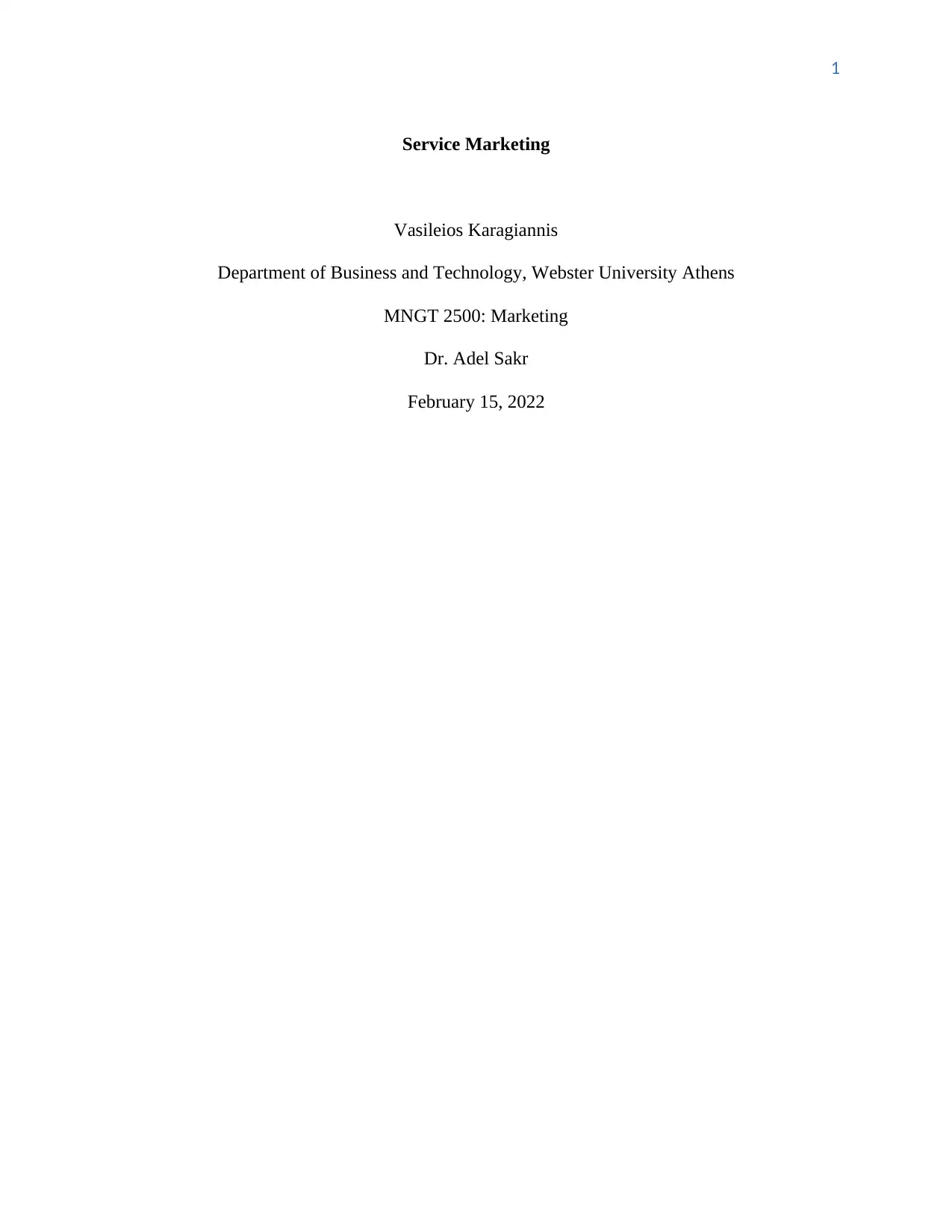
1
Service Marketing
Vasileios Karagiannis
Department of Business and Technology, Webster University Athens
MNGT 2500: Marketing
Dr. Adel Sakr
February 15, 2022
Service Marketing
Vasileios Karagiannis
Department of Business and Technology, Webster University Athens
MNGT 2500: Marketing
Dr. Adel Sakr
February 15, 2022
Paraphrase This Document
Need a fresh take? Get an instant paraphrase of this document with our AI Paraphraser
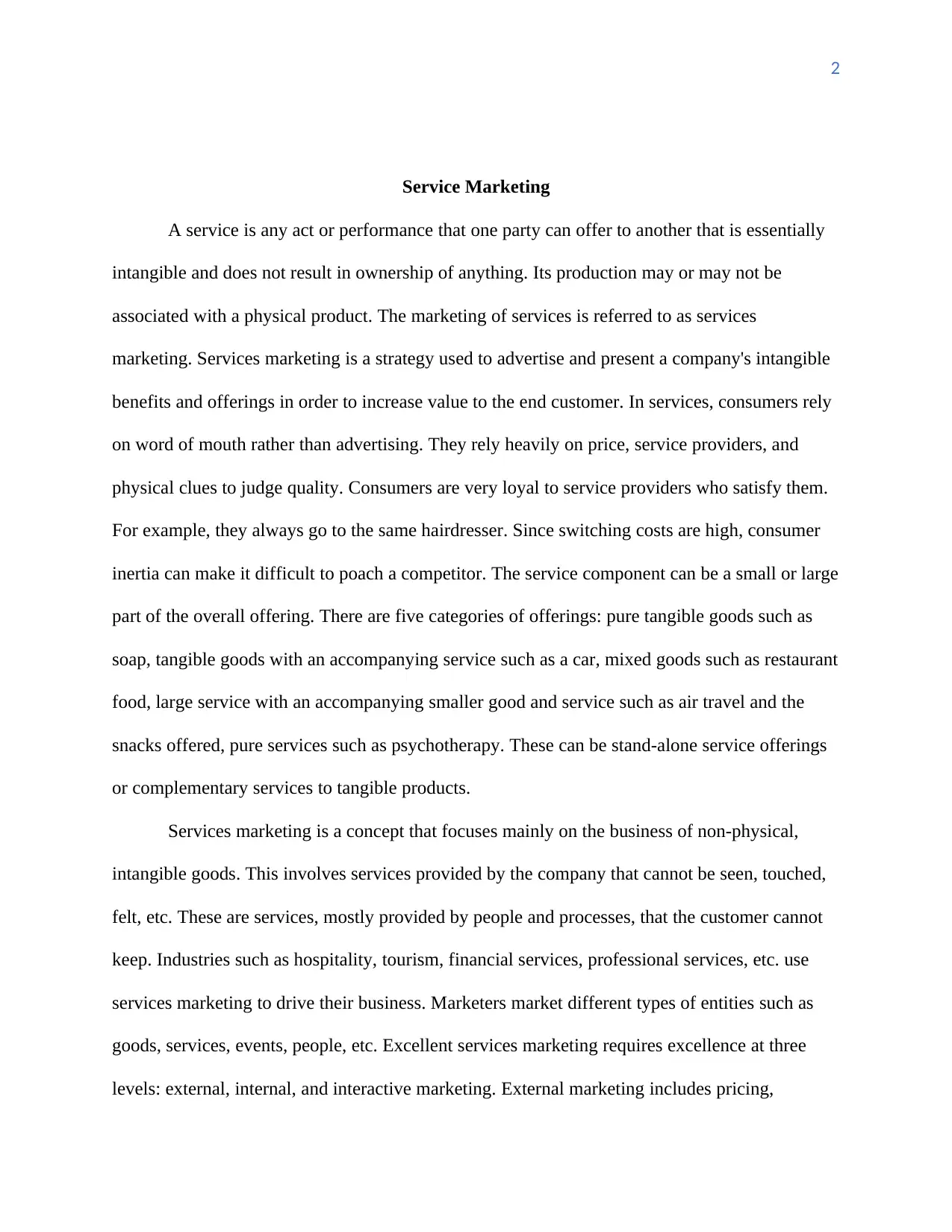
2
Service Marketing
A service is any act or performance that one party can offer to another that is essentially
intangible and does not result in ownership of anything. Its production may or may not be
associated with a physical product. The marketing of services is referred to as services
marketing. Services marketing is a strategy used to advertise and present a company's intangible
benefits and offerings in order to increase value to the end customer. In services, consumers rely
on word of mouth rather than advertising. They rely heavily on price, service providers, and
physical clues to judge quality. Consumers are very loyal to service providers who satisfy them.
For example, they always go to the same hairdresser. Since switching costs are high, consumer
inertia can make it difficult to poach a competitor. The service component can be a small or large
part of the overall offering. There are five categories of offerings: pure tangible goods such as
soap, tangible goods with an accompanying service such as a car, mixed goods such as restaurant
food, large service with an accompanying smaller good and service such as air travel and the
snacks offered, pure services such as psychotherapy. These can be stand-alone service offerings
or complementary services to tangible products.
Services marketing is a concept that focuses mainly on the business of non-physical,
intangible goods. This involves services provided by the company that cannot be seen, touched,
felt, etc. These are services, mostly provided by people and processes, that the customer cannot
keep. Industries such as hospitality, tourism, financial services, professional services, etc. use
services marketing to drive their business. Marketers market different types of entities such as
goods, services, events, people, etc. Excellent services marketing requires excellence at three
levels: external, internal, and interactive marketing. External marketing includes pricing,
Service Marketing
A service is any act or performance that one party can offer to another that is essentially
intangible and does not result in ownership of anything. Its production may or may not be
associated with a physical product. The marketing of services is referred to as services
marketing. Services marketing is a strategy used to advertise and present a company's intangible
benefits and offerings in order to increase value to the end customer. In services, consumers rely
on word of mouth rather than advertising. They rely heavily on price, service providers, and
physical clues to judge quality. Consumers are very loyal to service providers who satisfy them.
For example, they always go to the same hairdresser. Since switching costs are high, consumer
inertia can make it difficult to poach a competitor. The service component can be a small or large
part of the overall offering. There are five categories of offerings: pure tangible goods such as
soap, tangible goods with an accompanying service such as a car, mixed goods such as restaurant
food, large service with an accompanying smaller good and service such as air travel and the
snacks offered, pure services such as psychotherapy. These can be stand-alone service offerings
or complementary services to tangible products.
Services marketing is a concept that focuses mainly on the business of non-physical,
intangible goods. This involves services provided by the company that cannot be seen, touched,
felt, etc. These are services, mostly provided by people and processes, that the customer cannot
keep. Industries such as hospitality, tourism, financial services, professional services, etc. use
services marketing to drive their business. Marketers market different types of entities such as
goods, services, events, people, etc. Excellent services marketing requires excellence at three
levels: external, internal, and interactive marketing. External marketing includes pricing,
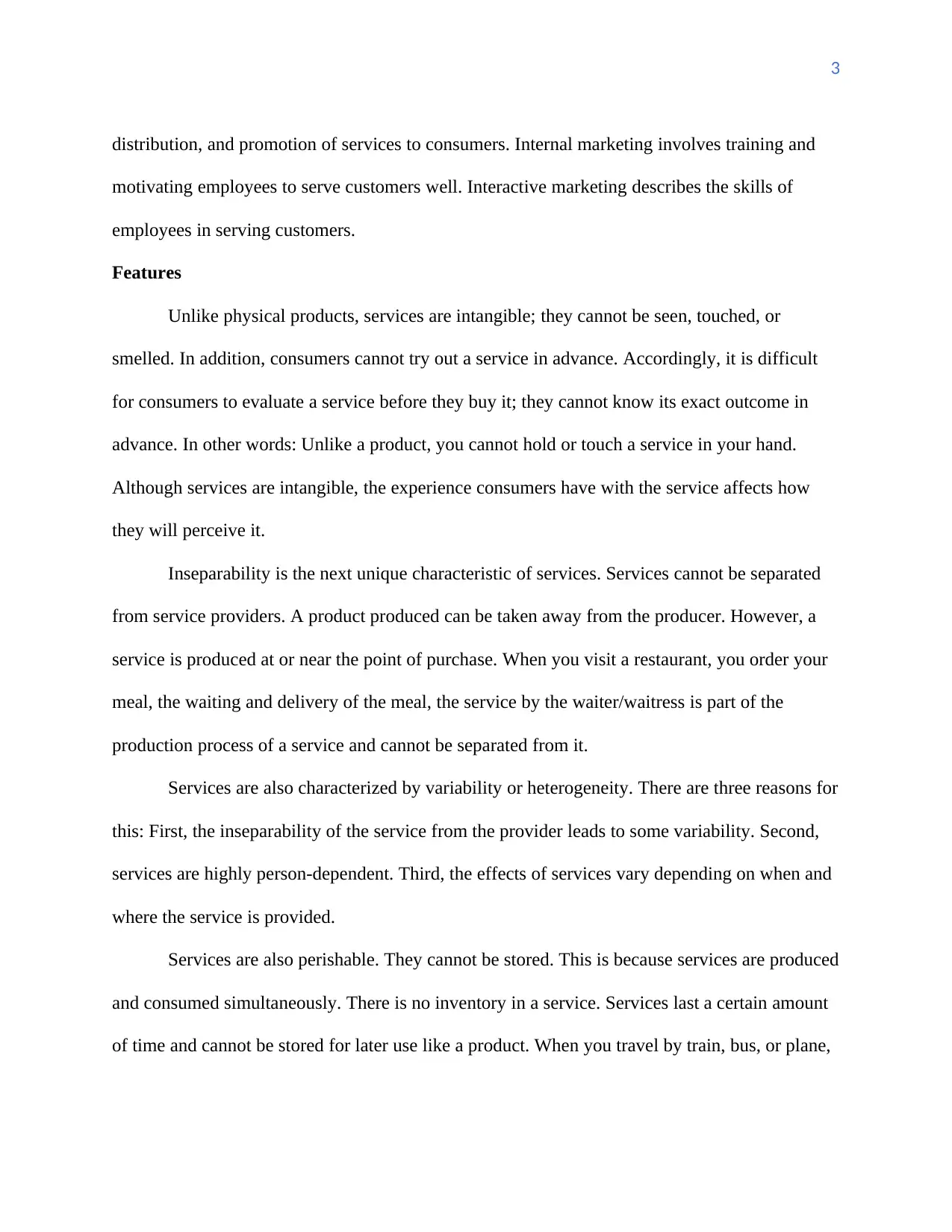
3
distribution, and promotion of services to consumers. Internal marketing involves training and
motivating employees to serve customers well. Interactive marketing describes the skills of
employees in serving customers.
Features
Unlike physical products, services are intangible; they cannot be seen, touched, or
smelled. In addition, consumers cannot try out a service in advance. Accordingly, it is difficult
for consumers to evaluate a service before they buy it; they cannot know its exact outcome in
advance. In other words: Unlike a product, you cannot hold or touch a service in your hand.
Although services are intangible, the experience consumers have with the service affects how
they will perceive it.
Inseparability is the next unique characteristic of services. Services cannot be separated
from service providers. A product produced can be taken away from the producer. However, a
service is produced at or near the point of purchase. When you visit a restaurant, you order your
meal, the waiting and delivery of the meal, the service by the waiter/waitress is part of the
production process of a service and cannot be separated from it.
Services are also characterized by variability or heterogeneity. There are three reasons for
this: First, the inseparability of the service from the provider leads to some variability. Second,
services are highly person-dependent. Third, the effects of services vary depending on when and
where the service is provided.
Services are also perishable. They cannot be stored. This is because services are produced
and consumed simultaneously. There is no inventory in a service. Services last a certain amount
of time and cannot be stored for later use like a product. When you travel by train, bus, or plane,
distribution, and promotion of services to consumers. Internal marketing involves training and
motivating employees to serve customers well. Interactive marketing describes the skills of
employees in serving customers.
Features
Unlike physical products, services are intangible; they cannot be seen, touched, or
smelled. In addition, consumers cannot try out a service in advance. Accordingly, it is difficult
for consumers to evaluate a service before they buy it; they cannot know its exact outcome in
advance. In other words: Unlike a product, you cannot hold or touch a service in your hand.
Although services are intangible, the experience consumers have with the service affects how
they will perceive it.
Inseparability is the next unique characteristic of services. Services cannot be separated
from service providers. A product produced can be taken away from the producer. However, a
service is produced at or near the point of purchase. When you visit a restaurant, you order your
meal, the waiting and delivery of the meal, the service by the waiter/waitress is part of the
production process of a service and cannot be separated from it.
Services are also characterized by variability or heterogeneity. There are three reasons for
this: First, the inseparability of the service from the provider leads to some variability. Second,
services are highly person-dependent. Third, the effects of services vary depending on when and
where the service is provided.
Services are also perishable. They cannot be stored. This is because services are produced
and consumed simultaneously. There is no inventory in a service. Services last a certain amount
of time and cannot be stored for later use like a product. When you travel by train, bus, or plane,
⊘ This is a preview!⊘
Do you want full access?
Subscribe today to unlock all pages.

Trusted by 1+ million students worldwide
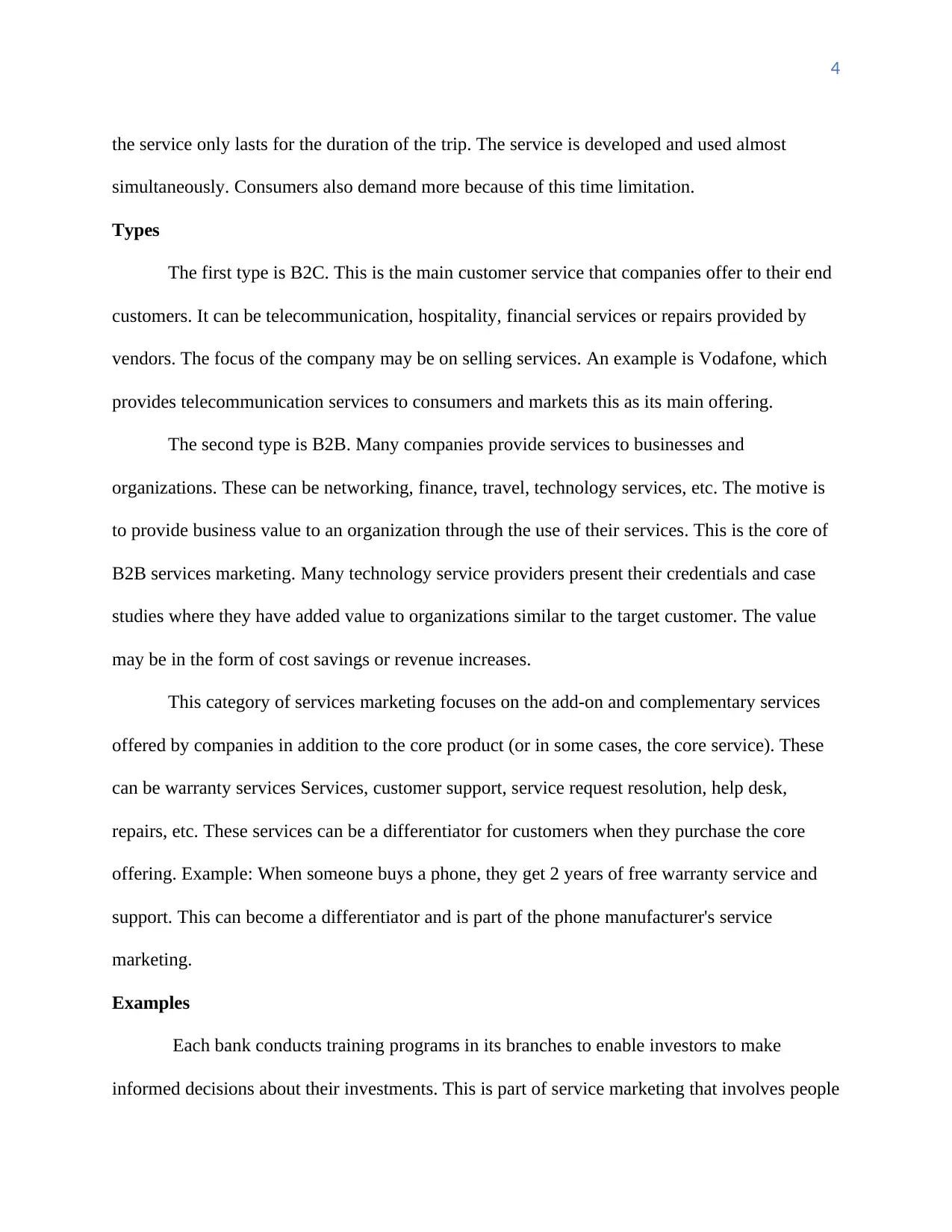
4
the service only lasts for the duration of the trip. The service is developed and used almost
simultaneously. Consumers also demand more because of this time limitation.
Types
The first type is B2C. This is the main customer service that companies offer to their end
customers. It can be telecommunication, hospitality, financial services or repairs provided by
vendors. The focus of the company may be on selling services. An example is Vodafone, which
provides telecommunication services to consumers and markets this as its main offering.
The second type is B2B. Many companies provide services to businesses and
organizations. These can be networking, finance, travel, technology services, etc. The motive is
to provide business value to an organization through the use of their services. This is the core of
B2B services marketing. Many technology service providers present their credentials and case
studies where they have added value to organizations similar to the target customer. The value
may be in the form of cost savings or revenue increases.
This category of services marketing focuses on the add-on and complementary services
offered by companies in addition to the core product (or in some cases, the core service). These
can be warranty services Services, customer support, service request resolution, help desk,
repairs, etc. These services can be a differentiator for customers when they purchase the core
offering. Example: When someone buys a phone, they get 2 years of free warranty service and
support. This can become a differentiator and is part of the phone manufacturer's service
marketing.
Examples
Each bank conducts training programs in its branches to enable investors to make
informed decisions about their investments. This is part of service marketing that involves people
the service only lasts for the duration of the trip. The service is developed and used almost
simultaneously. Consumers also demand more because of this time limitation.
Types
The first type is B2C. This is the main customer service that companies offer to their end
customers. It can be telecommunication, hospitality, financial services or repairs provided by
vendors. The focus of the company may be on selling services. An example is Vodafone, which
provides telecommunication services to consumers and markets this as its main offering.
The second type is B2B. Many companies provide services to businesses and
organizations. These can be networking, finance, travel, technology services, etc. The motive is
to provide business value to an organization through the use of their services. This is the core of
B2B services marketing. Many technology service providers present their credentials and case
studies where they have added value to organizations similar to the target customer. The value
may be in the form of cost savings or revenue increases.
This category of services marketing focuses on the add-on and complementary services
offered by companies in addition to the core product (or in some cases, the core service). These
can be warranty services Services, customer support, service request resolution, help desk,
repairs, etc. These services can be a differentiator for customers when they purchase the core
offering. Example: When someone buys a phone, they get 2 years of free warranty service and
support. This can become a differentiator and is part of the phone manufacturer's service
marketing.
Examples
Each bank conducts training programs in its branches to enable investors to make
informed decisions about their investments. This is part of service marketing that involves people
Paraphrase This Document
Need a fresh take? Get an instant paraphrase of this document with our AI Paraphraser
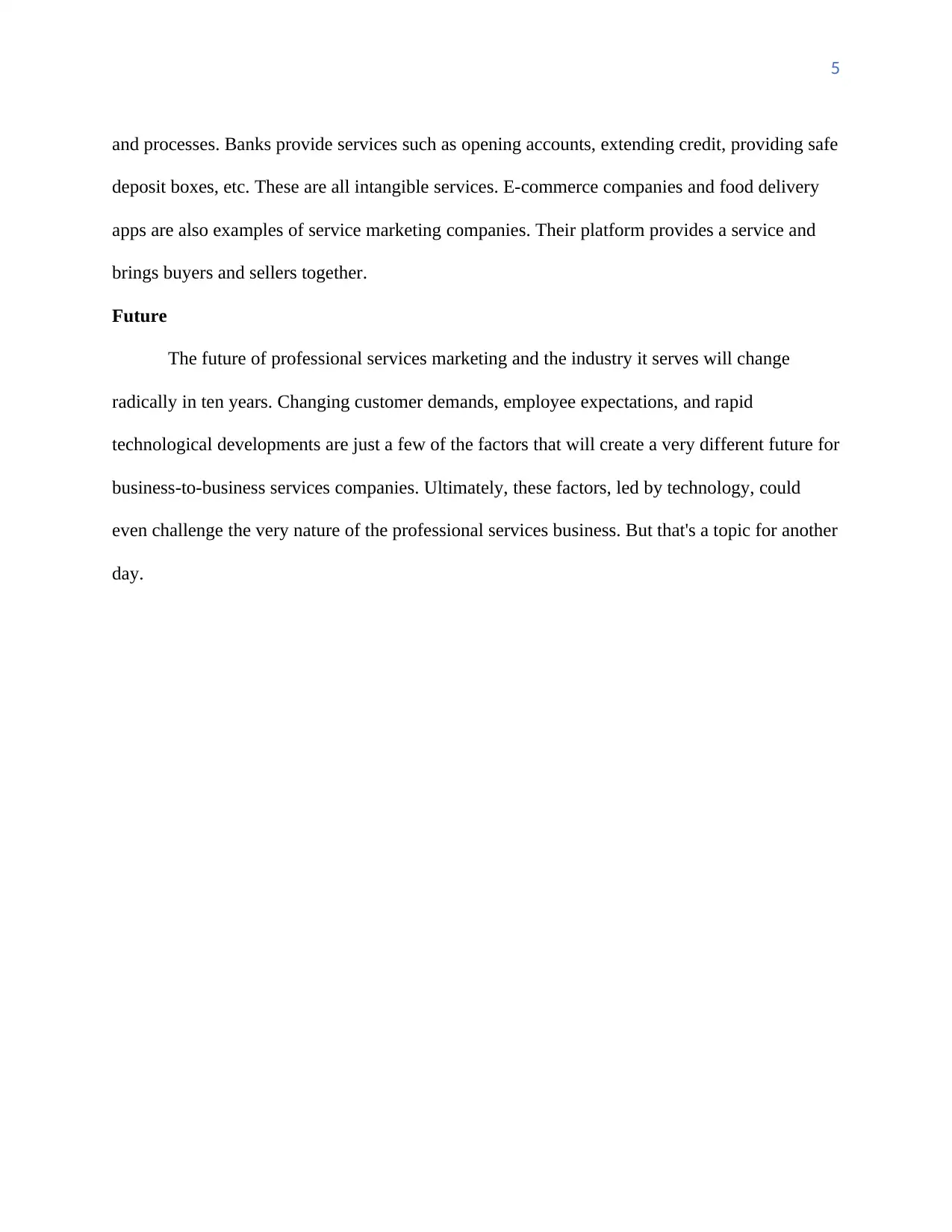
5
and processes. Banks provide services such as opening accounts, extending credit, providing safe
deposit boxes, etc. These are all intangible services. E-commerce companies and food delivery
apps are also examples of service marketing companies. Their platform provides a service and
brings buyers and sellers together.
Future
The future of professional services marketing and the industry it serves will change
radically in ten years. Changing customer demands, employee expectations, and rapid
technological developments are just a few of the factors that will create a very different future for
business-to-business services companies. Ultimately, these factors, led by technology, could
even challenge the very nature of the professional services business. But that's a topic for another
day.
and processes. Banks provide services such as opening accounts, extending credit, providing safe
deposit boxes, etc. These are all intangible services. E-commerce companies and food delivery
apps are also examples of service marketing companies. Their platform provides a service and
brings buyers and sellers together.
Future
The future of professional services marketing and the industry it serves will change
radically in ten years. Changing customer demands, employee expectations, and rapid
technological developments are just a few of the factors that will create a very different future for
business-to-business services companies. Ultimately, these factors, led by technology, could
even challenge the very nature of the professional services business. But that's a topic for another
day.
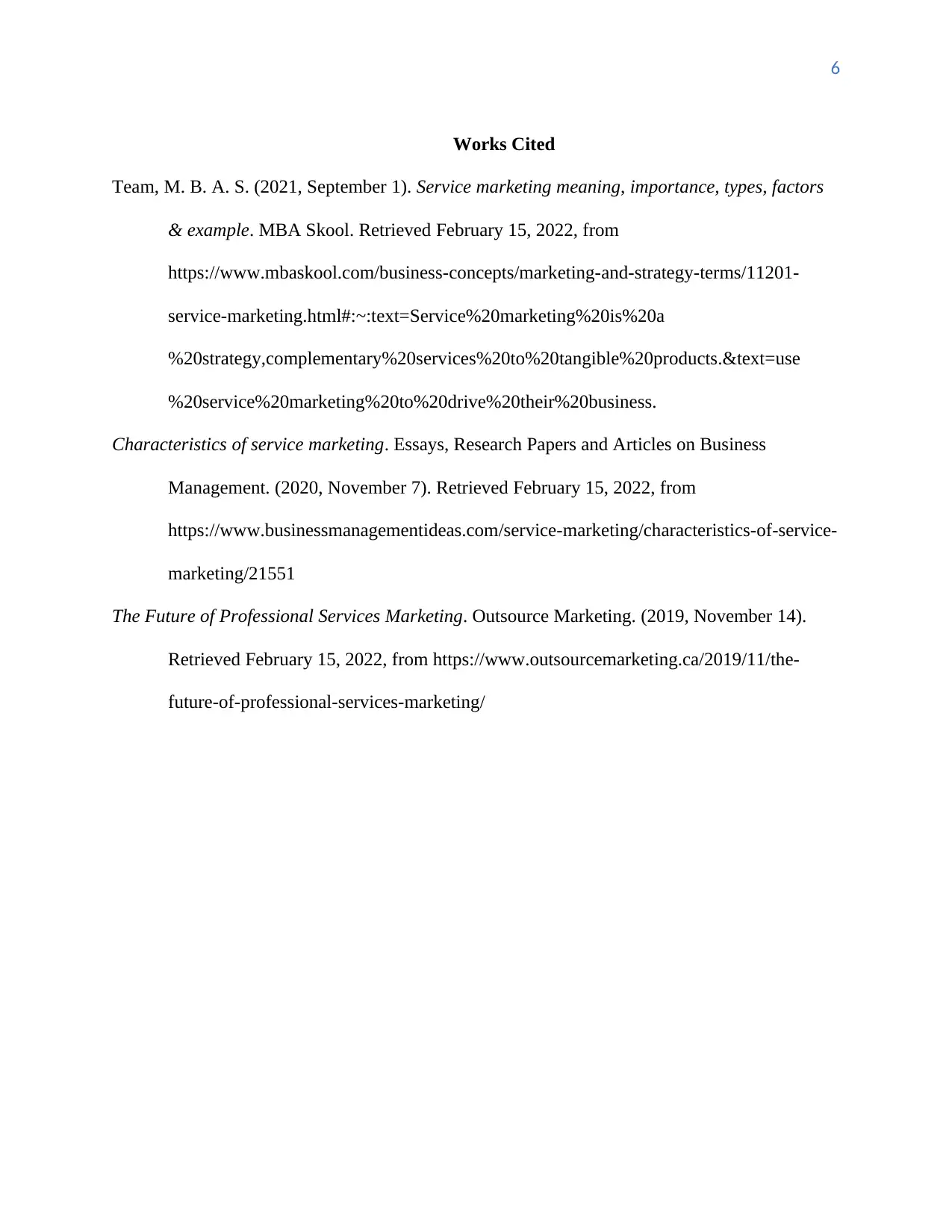
6
Works Cited
Team, M. B. A. S. (2021, September 1). Service marketing meaning, importance, types, factors
& example. MBA Skool. Retrieved February 15, 2022, from
https://www.mbaskool.com/business-concepts/marketing-and-strategy-terms/11201-
service-marketing.html#:~:text=Service%20marketing%20is%20a
%20strategy,complementary%20services%20to%20tangible%20products.&text=use
%20service%20marketing%20to%20drive%20their%20business.
Characteristics of service marketing. Essays, Research Papers and Articles on Business
Management. (2020, November 7). Retrieved February 15, 2022, from
https://www.businessmanagementideas.com/service-marketing/characteristics-of-service-
marketing/21551
The Future of Professional Services Marketing. Outsource Marketing. (2019, November 14).
Retrieved February 15, 2022, from https://www.outsourcemarketing.ca/2019/11/the-
future-of-professional-services-marketing/
Works Cited
Team, M. B. A. S. (2021, September 1). Service marketing meaning, importance, types, factors
& example. MBA Skool. Retrieved February 15, 2022, from
https://www.mbaskool.com/business-concepts/marketing-and-strategy-terms/11201-
service-marketing.html#:~:text=Service%20marketing%20is%20a
%20strategy,complementary%20services%20to%20tangible%20products.&text=use
%20service%20marketing%20to%20drive%20their%20business.
Characteristics of service marketing. Essays, Research Papers and Articles on Business
Management. (2020, November 7). Retrieved February 15, 2022, from
https://www.businessmanagementideas.com/service-marketing/characteristics-of-service-
marketing/21551
The Future of Professional Services Marketing. Outsource Marketing. (2019, November 14).
Retrieved February 15, 2022, from https://www.outsourcemarketing.ca/2019/11/the-
future-of-professional-services-marketing/
⊘ This is a preview!⊘
Do you want full access?
Subscribe today to unlock all pages.

Trusted by 1+ million students worldwide
1 out of 6
Related Documents
Your All-in-One AI-Powered Toolkit for Academic Success.
+13062052269
info@desklib.com
Available 24*7 on WhatsApp / Email
![[object Object]](/_next/static/media/star-bottom.7253800d.svg)
Unlock your academic potential
Copyright © 2020–2025 A2Z Services. All Rights Reserved. Developed and managed by ZUCOL.





